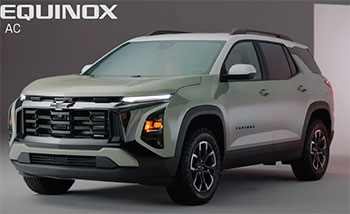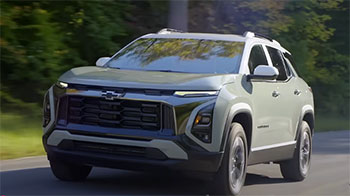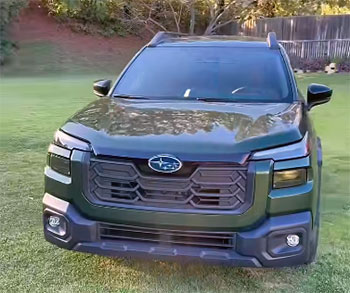When I set out to compare the Chevrolet Equinox and Subaru Outback, my goal was simple: to find out which compact SUV best suits the needs of everyday drivers like you and me. Both vehicles have carved out strong reputations in the crowded SUV market, offering practicality, comfort, and modern tech. In this article, I’ll share my firsthand insights, breaking down their key features, performance, and value to help you decide which one fits your lifestyle. From city commutes to weekend adventures, let’s see how these two stack up.
Comparison Table: Chevrolet Equinox Vs. Subaru Outback
| Feature | Chevrolet Equinox | Subaru Outback |
|---|---|---|
| Starting MSRP | $29,995 | $30,430 |
| Fuel Economy (City/Hwy) | 26/31 MPG | 25/32 MPG |
| Engine | 1.5L Turbo 4-cylinder (175 hp) | 2.5L Boxer 4-cylinder (182 hp) |
| Cargo Space (Max) | 63.5 cu. ft. | 75.6 cu. ft. |
| Passenger Volume | 103.5 cu. ft. | 109.0 cu. ft. |
| Towing Capacity | 1,500 lbs | 2,700 lbs |
| AWD Availability | Optional | Standard |
| NHTSA Safety Rating | 5 Stars | 5 Stars |
| Ground Clearance | 7.9 inches | 8.7 inches |
| Infotainment Screen | 7-inch (standard) | 11.6-inch (standard) |
My Experience With the Chevrolet Equinox

Driving the Chevrolet Equinox felt like slipping into a familiar pair of shoes—comfortable, reliable, and straightforward.
The Equinox is a compact SUV designed for those who want a practical vehicle without breaking the bank.
My test drive took me through urban streets and open highways, giving me a solid sense of its capabilities.
The 1.5-liter turbocharged four-cylinder engine, producing 175 horsepower, delivered a smooth and quiet ride, especially in city traffic. Its compact size—about 183 inches long—made parking in tight spots a breeze, a big plus for city dwellers like me.
The interior of the Equinox is functional, with a clean layout and easy-to-use controls. The standard 7-inch touchscreen infotainment system was responsive, supporting Apple CarPlay and Android Auto, which seamlessly connected to my phone for navigation and music.
The seats were supportive, and the cabin felt airy, though I noticed the materials leaned more toward durability than luxury. Rear legroom, at 39.9 inches, was generous for passengers, but the cargo space (29.8 cubic feet with seats up) felt a bit tight for a family road trip.
On the highway, the Equinox’s fuel economy—26 MPG city and 31 MPG highway—helped keep costs down, especially with gas prices fluctuating. The ride was composed, with minimal road noise thanks to active noise cancellation, a feature I appreciated during longer drives.
However, the engine felt underpowered when merging onto highways, and the six-speed automatic transmission was sometimes slow to shift. Safety-wise, the Equinox impressed with a five-star NHTSA rating and standard features like automatic emergency braking and lane departure warnings, though I wished for more advanced options in the base trim.
Overall, the Equinox struck me as a budget-friendly choice for practical drivers. It’s not flashy, but it gets the job done with a focus on comfort and efficiency. If you’re looking for an affordable SUV for daily commutes, the Equinox is a strong contender.
Pros Of the Chevrolet Equinox

- Affordable Price Point: Starting at $29,995, the Equinox is one of the most budget-friendly compact SUVs, undercutting the Outback by about $500, making it an attractive option for cost-conscious buyers.
- Fuel Efficiency: With 26 MPG in the city and 31 MPG on the highway, the Equinox sips fuel, especially in stop-and-go traffic, saving me money during my week-long test.
- Compact Size: At 183 inches long, it’s easier to maneuver and park than the larger Outback, a lifesaver in crowded urban lots or narrow streets.
- Smooth Ride Quality: The suspension absorbs bumps well, and active noise cancellation keeps the cabin quiet, making long drives relaxing.
- Standard Safety Features: A five-star NHTSA rating and features like automatic emergency braking, lane-keep assist, and a rearview camera provide peace of mind.
- Tech Integration: The 7-inch touchscreen with Apple CarPlay and Android Auto is intuitive, letting me stream music and use navigation effortlessly.
- Warranty Advantage: The Equinox offers a six-year corrosion warranty compared to the Outback’s five years, a small but notable perk for long-term ownership.
- Dealer Network: With nearly five times as many Chevrolet dealers as there are Subaru, finding service or repairs is more convenient, especially in rural areas.
The Equinox’s affordability was a standout for me. Its starting price of $29,995 meant I could get a well-equipped SUV without stretching my budget. During my test, I averaged about 28 MPG in mixed driving, which felt like a win given how often I’m stuck in traffic.
The compact dimensions made navigating tight city streets stress-free, and I could slip into parking spots that larger SUVs might struggle with. The ride quality was a pleasant surprise—smooth over potholes and quiet even on busy highways. Safety features gave me confidence, especially the automatic braking, which felt reassuring in heavy traffic.
The infotainment system was a breeze to use, syncing with my iPhone in seconds. The longer corrosion warranty and widespread dealer network also added a layer of practicality, knowing maintenance would be hassle-free. For budget-minded drivers who prioritize efficiency and ease, the Equinox delivers.
Cons Of the Chevrolet Equinox
- Underpowered Engine: The 1.5-liter engine’s 175 horsepower felt sluggish during highway merges, requiring more planning to overtake.
- Limited Cargo Space: With 29.8 cubic feet behind the rear seats, it’s less spacious than the Outback, making it less ideal for bulky gear or long trips.
- Basic Interior Materials: The cabin’s hard plastics and cloth seats lack the premium feel of competitors, which was noticeable compared to the Outback’s upscale trims.
- No Standard AWD: All-wheel drive is optional, adding cost, whereas the Outback includes it standard, a drawback for those in snowy regions.
- Fewer Safety Features: Lacking rear seat belt pretensioners and height-adjustable front belts, it trails the Outback in advanced safety.
- Smaller Infotainment Screen: The standard 7-inch touchscreen feels dated compared to the Outback’s 11.6-inch display, especially for tech-savvy drivers.
- Lower Towing Capacity: At 1,500 pounds, it’s significantly less capable than the Outback’s 2,700 pounds, limiting its utility for towing.
- Less Off-Road Capability: Without features like the Outback’s X-Mode, it’s less suited for off-road adventures or rough terrain.
The Equinox’s engine was my biggest gripe. It struggled during quick acceleration, like when I needed to merge onto a busy highway, making me wish for more power. Cargo space was another letdown; fitting a weekend’s worth of camping gear was a tight squeeze compared to what I could manage in the Outback.
The interior, while functional, felt a bit cheap with its hard plastics, especially when I compared it to the Outback’s softer touches. Not having standard AWD was frustrating, as it’s a must for me in winter weather. The smaller touchscreen, while functional, didn’t wow me, and the lack of advanced safety features like rear pretensioners felt like a miss.
Towing capacity was also a limiting factor—1,500 pounds meant I couldn’t haul much beyond a small trailer. For off-road enthusiasts, the Equinox’s road-focused design falls short of the Outback’s rugged capabilities.
My Experience With the Subaru Outback

The Subaru Outback felt like a trusty companion for adventure. Its wagon-like design and standard all-wheel drive gave it a rugged edge, perfect for my weekend escapes to the mountains.
Powered by a 2.5-liter boxer engine producing 182 horsepower, it offered a bit more pep than the Equinox, especially on winding roads. The Outback’s 8.7-inch ground clearance and X-Mode system made light work of gravel paths, giving me confidence in tougher conditions.
Its 191-inch length made it slightly harder to park, but the spacious interior more than made up for it.
Inside, the Outback’s 109 cubic feet of passenger volume felt roomy, with 42.8 inches of front legroom letting me stretch out comfortably. The 11.6-inch vertical touchscreen was a highlight, offering crisp graphics and easy navigation, though it took a day to get used to its layout.
Cargo space was a game-changer—32.6 cubic feet behind the seats and 75.6 cubic feet with them folded meant I could pack bikes, camping gear, and more without hassle. The ride was firm but composed, though I noticed more road noise than in the Equinox.
Fuel economy, at 25 MPG city and 32 MPG highway, was slightly better than the Equinox on open roads, and the Outback’s towing capacity of 2,700 pounds impressed me for its class. Safety was top-notch, with a five-star NHTSA rating and features like EyeSight Driver Assist, including adaptive cruise control and a driver’s knee airbag.
However, the higher starting price of $30,430 and some reliability concerns from past models gave me pause. For those who love outdoor adventures and need space, the Outback is a compelling choice.
Pros Of the Subaru Outback
- Standard All-Wheel Drive: AWD comes standard, making it ideal for snow, rain, or off-road trails, giving me confidence in all conditions.
- Spacious Cargo Area: With 32.6 cubic feet behind the seats and 75.6 cubic feet max, it easily handled my camping gear and bikes.
- Higher Towing Capacity: At 2,700 pounds, it can tow small trailers or boats, outpacing the Equinox’s 1,500-pound limit.
- Advanced Safety Features: EyeSight technology, rear pretensioners, and a driver’s knee airbag make it a safety standout.
- Off-Road Capability: X-Mode and 8.7-inch ground clearance let me tackle dirt roads and steep inclines with ease.
- Large Infotainment Screen: The 11.6-inch touchscreen is modern and responsive, elevating the cabin’s tech appeal.
- Better Resale Value: The Outback retains 5.9% more value over five years compared to the Equinox, a win for long-term owners.
- Roomy Interior: 109 cubic feet of passenger volume and 42.8 inches of front legroom made it feel spacious and comfortable.
The Outback’s standard AWD was a game-changer during my mountain drives, handling slick roads without breaking a sweat. The cargo space was a dream—I loaded up two bikes and a cooler with room to spare, something the Equinox couldn’t match. Towing capacity was another plus; I could easily see myself hauling a small camper for a weekend getaway. The safety suite, especially EyeSight, felt like having an extra set of eyes on the road, and the knee airbag was a thoughtful touch. X-Mode made off-road trails fun rather than stressful, and the big touchscreen added a premium feel. The Outback’s resale value also gave me confidence that it’s a smart investment. For adventure-seekers, this SUV feels tailor-made.
Cons Of the Subaru Outback
- Higher Starting Price: At $30,430, it’s pricier than the Equinox, which could stretch budgets for some buyers.
- Noisier Cabin: Without active noise cancellation, road noise was more noticeable on highways compared to the Equinox.
- Steeper Learning Curve for Tech: The 11.6-inch touchscreen, while impressive, took time to navigate compared to the Equinox’s simpler system.
- Lower City Fuel Economy: At 25 MPG city, it’s slightly less efficient than the Equinox in urban driving.
- Longer Body: At 191 inches, it’s harder to park in tight spaces, a challenge in urban environments.
- Reliability Concerns: Past models had head gasket issues, and while improved, Consumer Reports rates it slightly below the Equinox.
- Firm Ride: The suspension is stiffer than the Equinox’s, which some might find less comfortable on long drives.
- Higher Maintenance Costs: Repairs can be pricier due to fewer Subaru dealers and specialized parts.
The Outback’s price tag was a sticking point—it’s about $500 more than the Equinox, which adds up when budgeting. Road noise was noticeable on highways, making conversations slightly harder than in the quieter Equinox. The big touchscreen, while cool, felt overwhelming at first, with menus that weren’t as intuitive as I’d hoped. City fuel economy was a tad lower, which I felt during stop-and-go drives.
The longer body made parking a bit trickier in tight lots. Reliability concerns from older Outbacks lingered in my mind, especially reports of costly head gasket repairs. The firmer ride was fine for off-road jaunts but less plush on long highway stretches. Maintenance costs also worried me, given the smaller Subaru dealer network.
Frequently Asked Questions (FAQ)
The Subaru Outback is the closest equivalent to the Chevrolet Equinox, both being compact SUVs with similar seating and cargo capacities, though the Outback offers standard AWD and more off-road capability.
Subaru’s reliability rating is slightly higher (8.6/10 vs. 8.0/10 per iSeeCars), but Chevy’s wider dealer network makes repairs easier. Consumer Reports notes Subaru’s edge in reliability.
The Equinox has a less powerful engine, limited cargo space, basic interior materials, optional AWD, fewer advanced safety features, and lower towing capacity compared to competitors like the Outback.
The Subaru Outback often outperforms the Equinox in cargo space, towing, AWD, and off-road capability. Other strong options include the Toyota RAV4 and Honda CR-V for reliability and features.
Conclusion: For Chevrolet Equinox and Subaru Outback
Choosing between the Chevrolet Equinox and Subaru Outback depends on what you value most in an SUV. If you’re after affordability, fuel efficiency, and a compact size for city driving, the Equinox is your go-to. Its smooth ride, strong safety ratings, and budget-friendly price make it ideal for daily commutes and small families. However, if adventure calls and you need more cargo space, towing power, and standard AWD, the Outback is your match. Its off-road prowess and spacious interior cater to outdoor enthusiasts. Both SUVs are solid, but your lifestyle—city convenience or rugged exploration—will tip the scales.

